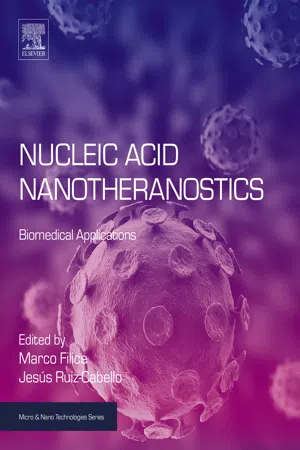
- 491 pages
- English
- ePUB (mobile friendly)
- Available on iOS & Android
About This Book
Nucleic Acid Nanotheranostics: Biomedical Applications offers a comprehensive overview of improvements and new trends in fabrication of nanostructures as theranostic multifunctional carriers in gene therapy. With a strong focus on medical applications (comprising diagnosis, therapy and imaging), the book also examines gene therapy in an individual patient's cells or tissues to treat genetic diseases. Sections cover Biomedical and Diagnostic applications of Nucleic Acids, Biologic and Synthetic Advanced Nanostructures for nucleic acid delivery, and important considerations of nanomedicine. This book is a valuable guide for materials scientists, physicians, chemists and engineers, but is also ideal for clinicians wishing to expand their knowledge.
- Provides a unique source of knowledge (theoretical as well as practical) on nanotheranostic materials for gene therapy at all levels and related scientific areas
- Covers the pros and cons related to viral and nanomaterial-based delivery of nucleic acids in terms of biosafety, carrier selection, synthesis and bioimaging
- Presents the only book to include an analysis of nanoformulations approved for clinical use
Frequently asked questions
Information
Therapeutic Oligonucleotides Against Cancer: Recent Approaches and New Perspectives
Abstract
Keywords
1 Introduction
2 Mechanisms of Action
2.1 Antisense Oligodeoxynucleotides (AS-ODNs)

Table of contents
- Cover image
- Title page
- Table of Contents
- Copyright
- Dedication
- Contributors
- Preface
- Acknowledgments
- Chapter 1: Therapeutic Oligonucleotides Against Cancer: Recent Approaches and New Perspectives
- Chapter 2: Small Interfering RNA-Mediated Silencing of the Ribophorin II Gene: Advances in the Treatment of Malignant Breast Cancer
- Chapter 3: Noncoding RNAs in Cardiovascular Disease
- Chapter 4: MicroRNAs in Respiratory Diseases
- Chapter 5: State of the Art and Future Direction for the Analysis of Cell-Free Circulating DNA
- Chapter 6: Aptamer-Based Strategies for Diagnostics
- Chapter 7: Viral Vectors for Treatment of Human Disease: Therapeutic and Manufacturing Challenges
- Chapter 8: Nonviral Gene Therapy: Peptiplexes
- Chapter 9: Controlling Protein Expression by Delivery of RNA Therapeutics Using Lipid Nanoparticles
- Chapter 10: Advanced Polymers for Nonviral Gene Delivery
- Chapter 11: Nonviral Gene Therapy: Design and Application of Inorganic Nanoplexes
- Chapter 12: Extracellular Vesicles as Novel Nanocarriers for Therapeutic Delivery
- Chapter 13: Nanocarrier-Based Gene Therapy Imaging Strategies
- Chapter 14: The State of the Art of Investigational and Approved Nanomedicine Products for Nucleic Acid Delivery
- Conclusions and Future Outlook
- Index